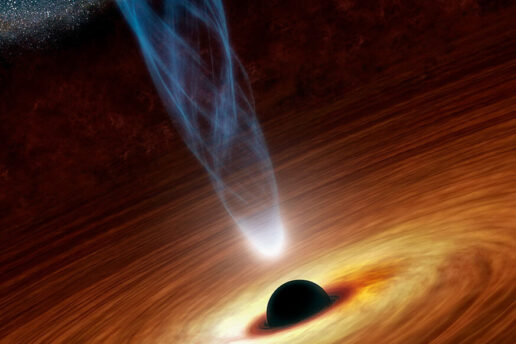
Giant black hole formed puzzlingly fast at dawn of cosmos
Quasar 40 million times the Sun’s mass challenges theorists
Astronomers have found by far the most distant and earliest quasar ever seen, a cosmic beacon shining so soon after the big bang that standard theory can’t explain how it was built.
Among the most luminous objects in the cosmos, quasars are powered by supermassive black holes in the center of galaxies, which suck in matter so voraciously that it becomes white hot from friction and glows brightly enough to be seen across the universe. Astronomers thought the black holes formed stepwise within early galaxies, as giant stars collapsed and merged, but quasars detected from when the universe was less than 1 billion years old have challenged the idea. “We were already concerned,” says Anna-Christina Eilers of the Massachusetts Institute of Technology. The new one, dubbed UHZ-1, which blazed when the universe was less than 450 million years old, has made that scenario untenable.
It’s not just UHZ-1’s early date, confirmed in a preprint posted on 5 August. The observations show its black hole is so large compared with the galaxy around it that it can’t have evolved slowly at the galaxy’s heart, but must have formed rapidly, by an entirely different process.
UHZ-1 was first seen as a tiny speck of light in an image made by JWST, NASA’s new infrared space telescope, of a megacluster of galaxies residing 4 billion light-years from Earth. The gravity of the giant cluster bends light like a giant lens, magnifying more distant objects behind it and making them easier to study. A few of the magnified dots appeared to be galaxies from when the universe was less than half a billion years old—among the earliest ever seen.
To see whether any of those galaxy candidates harbored quasars, observers viewed the area with another NASA space observatory, Chandra, which can detect the x-rays that are the most reliable signature of quasars. “One object stood out,” says team member Andy Goulding of Princeton University. “It was booming” in x-rays.
The x-ray brightness implied that the accreting black hole had a mass roughly 40 million times the mass of our Sun. The team then went back to JWST to make sure the quasar was as early as it appeared to be in the original images. By analyzing how far certain features in its spectrum are shifted toward longer, redder wavelengths by expansion of the universe, they confirmed they were seeing the quasar at between 400 million and 450 million years after the big bang.
“It’s hard to argue that it’s anything other than a black hole,” says Daniel Whalen of the University of Portsmouth—one far too big and too early for the conventional picture to explain. That scenario starts soon after the big bang, 13.7 billion years ago, as clumps of the mysterious dark matter that pervades the universe draw in primordial gases—mostly hydrogen and helium. The gases coalesce into giant “population III” stars, which swiftly burn up all their fuel and collapse into black holes with masses at most a few hundred times that of the Sun. Those early black holes would be the “seeds” for future supermassive ones. They would grow by accreting more gas, merge with other seeds, and pull in stars to form a galaxy around themselves.
Some theorists already doubted that this stepwise process could produce the earliest quasars, and that much larger seeds were needed. The same spectrum that confirmed UHZ-1’s distance suggests they were right. It allowed astronomers to estimate the mass of the galaxy: At 140 million times that of the Sun, it was only a few times the mass of the black hole at its heart. In contrast, quasars seen later in cosmic history are dwarfed by their galaxies, being 0.1% of the mass or less. To grow so large compared with its host galaxy and so soon after the big bang, the quasar must have had a head start. UHZ-1 “doesn’t put the last nail in the coffin lid” of light seeds, Whalen says. “But you really couldn’t have formed this from population III stars.”
In another preprint, posted on 4 August, Goulding and others argue that UHZ-1 fits a model proposed in 2017, in which radiation from early stars prevents a giant gas cloud nearby from cooling, fragmenting, and collapsing into more stars. Eventually, that cloud becomes unstable and collapses into a single black hole tens of thousands or even hundreds of thousands of times the mass of our Sun. This hefty seed could then merge with a nearby galaxy in formation and quickly grow into an outsize black hole like UHZ-1.
Another, more exotic possibility was presented in the Proceedings of the National Academy of Sciences last month by Katherine Freese of the University of Texas at Austin and colleagues: huge, puffy stars powered by dark matter. These “dark stars” would burn slowly, powered by the energy that some speculative forms of dark matter might give off, and over time would grow to 1 million times the mass of the Sun. When its dark matter power source gives out, a dark star would quickly collapse into a 1-million-solar-mass black hole—a perfect large seed ready to be adopted by a nearby protogalaxy. Freese says another JWST survey has already found three objects in the early universe that bear hallmarks of being dark stars.
Giant gas clouds and dark stars are only two of the scenarios theorists have devised for jump-starting the growth of quasars. Now, it’s up to observers to figure out which could be real. “We need more observations and for sure they will come for such a fascinating source,” says Melanie Habouzit of the Max Planck Institute for Astronomy.
doi: 10.1126/science.adk4468